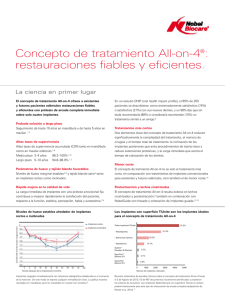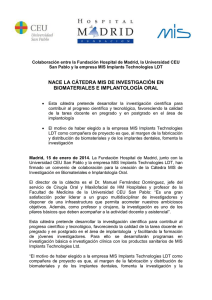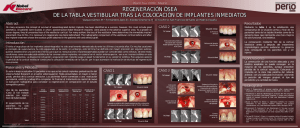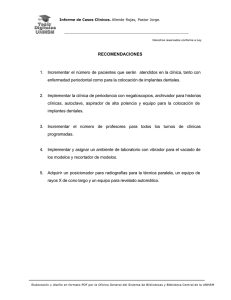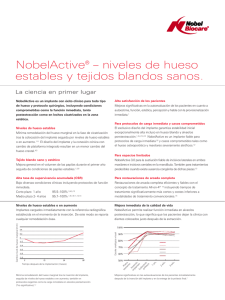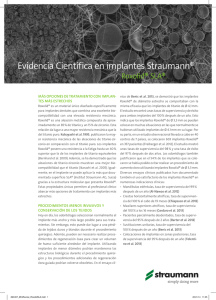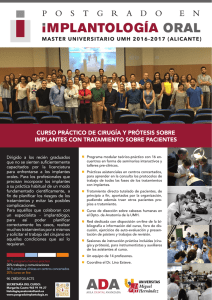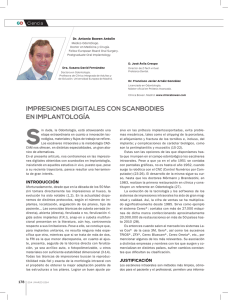Implantes en arbotantes anatómicos del maxilar superior Implants in
Anuncio
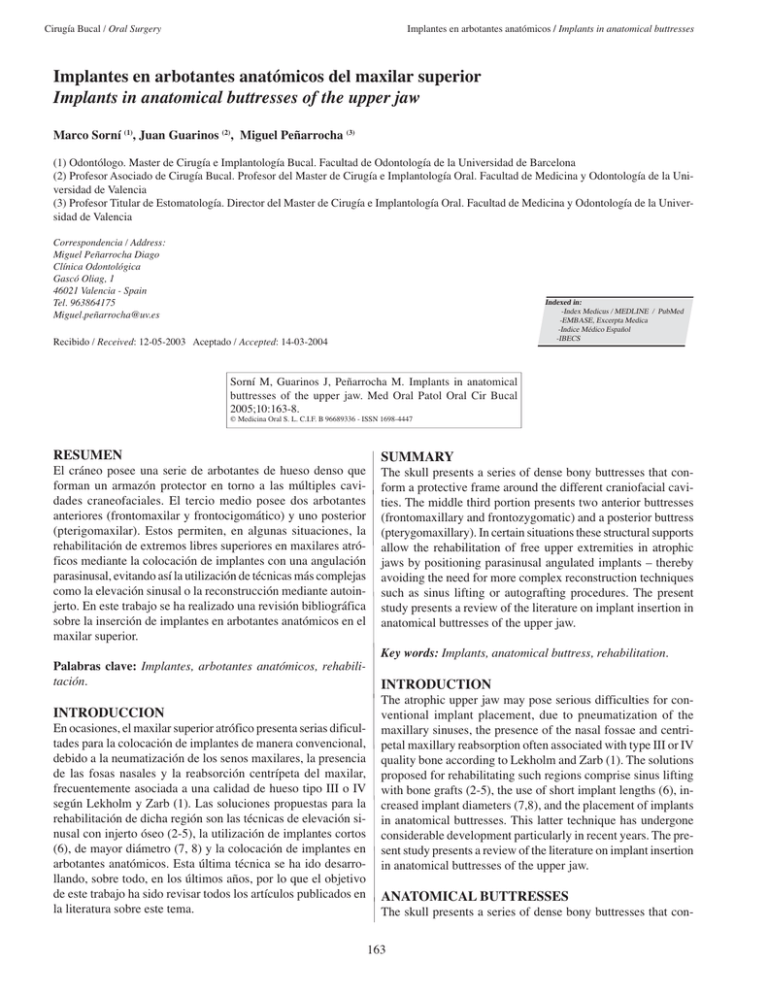
Cirugía Bucal / Oral Surgery Implantes en arbotantes anatómicos / Implants in anatomical buttresses Implantes en arbotantes anatómicos del maxilar superior Implants in anatomical buttresses of the upper jaw Marco Sorní (1), Juan Guarinos (2), Miguel Peñarrocha (3) (1) Odontólogo. Master de Cirugía e Implantología Bucal. Facultad de Odontología de la Universidad de Barcelona (2) Profesor Asociado de Cirugía Bucal. Profesor del Master de Cirugía e Implantología Oral. Facultad de Medicina y Odontología de la Universidad de Valencia (3) Profesor Titular de Estomatología. Director del Master de Cirugía e Implantología Oral. Facultad de Medicina y Odontología de la Universidad de Valencia Correspondencia / Address: Miguel Peñarrocha Diago Clínica Odontológica Gascó Oliag, 1 46021 Valencia - Spain Tel. 963864175 Miguel.peñ[email protected] Indexed in: -Index Medicus / MEDLINE / PubMed -EMBASE, Excerpta Medica -Indice Médico Español -IBECS Recibido / Received: 12-05-2003 Aceptado / Accepted: 14-03-2004 Sorní M, Guarinos J, Peñarrocha M. Implants in anatomical buttresses of the upper jaw. Med Oral Patol Oral Cir Bucal 2005;10:163-8. © Medicina Oral S. L. C.I.F. B 96689336 - ISSN 1698-4447 RESUMEN SUMMARY El cráneo posee una serie de arbotantes de hueso denso que forman un armazón protector en torno a las múltiples cavidades craneofaciales. El tercio medio posee dos arbotantes anteriores (frontomaxilar y frontocigomático) y uno posterior (pterigomaxilar). Estos permiten, en algunas situaciones, la rehabilitación de extremos libres superiores en maxilares atróficos mediante la colocación de implantes con una angulación parasinusal, evitando así la utilización de técnicas más complejas como la elevación sinusal o la reconstrucción mediante autoinjerto. En este trabajo se ha realizado una revisión bibliográfica sobre la inserción de implantes en arbotantes anatómicos en el maxilar superior. The skull presents a series of dense bony buttresses that conform a protective frame around the different craniofacial cavities. The middle third portion presents two anterior buttresses (frontomaxillary and frontozygomatic) and a posterior buttress (pterygomaxillary). In certain situations these structural supports allow the rehabilitation of free upper extremities in atrophic jaws by positioning parasinusal angulated implants – thereby avoiding the need for more complex reconstruction techniques such as sinus lifting or autografting procedures. The present study presents a review of the literature on implant insertion in anatomical buttresses of the upper jaw. Key words: Implants, anatomical buttress, rehabilitation. Palabras clave: Implantes, arbotantes anatómicos, rehabilitación. INTRODUCCION En ocasiones, el maxilar superior atrófico presenta serias dificultades para la colocación de implantes de manera convencional, debido a la neumatización de los senos maxilares, la presencia de las fosas nasales y la reabsorción centrípeta del maxilar, frecuentemente asociada a una calidad de hueso tipo III o IV según Lekholm y Zarb (1). Las soluciones propuestas para la rehabilitación de dicha región son las técnicas de elevación sinusal con injerto óseo (2-5), la utilización de implantes cortos (6), de mayor diámetro (7, 8) y la colocación de implantes en arbotantes anatómicos. Esta última técnica se ha ido desarrollando, sobre todo, en los últimos años, por lo que el objetivo de este trabajo ha sido revisar todos los artículos publicados en la literatura sobre este tema. INTRODUCTION The atrophic upper jaw may pose serious difficulties for conventional implant placement, due to pneumatization of the maxillary sinuses, the presence of the nasal fossae and centripetal maxillary reabsorption often associated with type III or IV quality bone according to Lekholm and Zarb (1). The solutions proposed for rehabilitating such regions comprise sinus lifting with bone grafts (2-5), the use of short implant lengths (6), increased implant diameters (7,8), and the placement of implants in anatomical buttresses. This latter technique has undergone considerable development particularly in recent years. The present study presents a review of the literature on implant insertion in anatomical buttresses of the upper jaw. ANATOMICAL BUTTRESSES The skull presents a series of dense bony buttresses that con163 Med Oral Patol Oral Cir Bucal 2005;10:163-8. ARBOTANTES ANATOMICOS El cráneo posee una serie de arbotantes de hueso denso que forman un armazón protector en torno a las múltiples cavidades craneofaciales (orbita, fosas nasales, cavidad bucal y senos paranasales), cuyas paredes son frágiles en su mayor parte. Dichos arbotantes distribuyen las fuerzas a través del macizo facial y presentan una disposición estratégica en cada uno de los tercios faciales. El tercio medio posee dos arbotantes anteriores (frontomaxilar y frontocigomático) y uno posterior (pterigomaxilar). ARBOTANTE FRONTOMAXILAR O CANINO Este pilar se origina en el alveolo del canino superior, sigue el borde lateral de la apertura piriforme, forma el proceso frontal del maxilar y se une al borde medial del arco supraorbitario. La parte inferior se interpone entre la cavidad nasal y el seno maxilar y tiene forma triangular. Esta región está formada normalmente por una cortical compacta y un hueso medular denso, lo que permite colocar implantes largos y con una angulación parasinusal (9). El proceso quirúrgico consiste en la inserción del implante con una angulación hacia distal, buscando la bicorticalización con el suelo del seno maxilar o de la fosa nasal. En estos casos los osteodilatadores sirven de gran ayuda en el labrado del lecho del implante, sobre todo en casos con crestas alveolares estrechas (10). Krekmanov y Rangert (11) introdujeron implantes paralelos a la pared anterior del seno en combinación con implantes verticales en la región anterior, en 20 pacientes. Con ello se consiguió extender la prótesis fija más de 9 mm. No se perdió ningún implante tras dos años de seguimiento. Mattsson y cols. (12) realizaron un estudio similar donde colocaron implantes anteriores en combinación con implantes angulados en la región canina en 15 pacientes edéntulos. Para ello fenestraron el seno maxilar, con la intención de explorar la pared anterior del seno, e introdujeron el implante en la zona del canino o primer premolar con una angulación mesio-distal y ligeramente hacia palatino, quedando unas cuantas espiras expuestas en la parte coronal. En total se colocaron de 4 a 6 implantes en cada paciente. Tras un período medio de observación de 45 meses, solamente se perdió un implante y todas las prótesis fijas seguían estables. Guarinos y cols. (13) describieron una variante de esta técnica mediante la utilización de osteótomos en tres casos clínicos. Los autores comentan que la principal ventaja de los osteótomos es que permite expandir el maxilar superior en casos de crestas alveolares estrechas o que presenten concavidades. Krekmanov y cols. (14) introdujeron 138 implantes en 22 maxilares superiores atróficos. 40 de estos implantes fueron colocados con angulación parasinusal, siguiendo la curvatura del seno maxilar. Se descubrieron los implantes a los 6 meses y en todos los casos se conectaron prótesis fijas. Durante un período de 4 años se perdieron cinco implantes no angulados y un implante angulado, obteniendo un porcentaje de éxito del 92,5% y 95,7% respectivamente. Los autores comentan que las principales ventajas de esta técnica son la reducción del cantilever de la prótesis, la obtención de una mayor corticalización, una mejor estabilidad primaria, y la utilización de implantes más largos. Implantes en arbotantes anatómicos / Implants in anatomical buttresses form a protective frame around the different craniofacial cavities (orbit, nasal fossae or passages, oral cavity and paranasal sinuses) with mostly fragile walls. These buttresses distribute forces through the solid facial bone structure, and are distributed strategically throughout the three facial thirds of the skull. In this context, the middle third portion presents two anterior buttresses (frontomaxillary and frontozygomatic) and a posterior buttress (pterygomaxillary). FRONTOMAXILLARY OR CANINE BUTTRESS This support or abutment originates in the alveolus of the upper canine, following along the lateral margin of the piriform aperture, forming the frontal process of the upper jaw and merging with the medial margin of the supraorbital arch. The lower portion is interpositioned between the nasal cavity and the maxillary sinus, and is triangular in shape. This region normally presents a compact cortical layer and dense medullary bone – thus allowing the placement of long implants with parasinusal angulation (9). The surgical process consists of implant positioning with distal angulation, seeking bicorticalization with the floor of the maxillary sinus or nasal fossa. In these cases osteodilators are of great help in preparing the implant bed – particularly in patients presenting narrow alveolar crests (10). Krekmanov and Rangert (11) introduced implants parallel to the anterior wall of the sinus, combined with vertical implants in the anterior region, in a series of 20 patients. This procedure made it possible to extend the fixed prosthesis more than 9 mm. No implants were lost during the two years of follow-up. Mattsson et al. (12) conducted a similar study in which anterior implants were placed in combination with tilted implants positioned in the canine region in 15 edentulous patients. To this effect the authors opened a window in the maxillary sinus to explore the anterior wall of the sinus, and introduced the implant in the zone of the canine or first premolar, adopting a mesiodistal angulation and slightly palatal orientation – leaving a few implant threads exposed in the coronal portion. Four to 6 implants were placed in each patient. After an average followup period of 45 months, only one implant was lost, and all the fixed prostheses remained stable. Guarinos et al. (13) described a variant of this technique based on the use of osteotomes, in three clinical cases. According to the authors, the main advantage of this approach was that it allows upper jaw expansion in patients presenting narrow alveolar crests or concavities. Krekmanov et al. (14) positioned 138 implants in 22 atrophic upper jaws. Forty of these implants presented a parasinusal angulation, following the curvature of the maxillary sinus. The implants were exposed after 6 months, with the positioning of fixed prostheses in all cases. Over a four-year period 5 nonangulated and a single angulated implant were lost – yielding a success rate of 92.5% and 95.7%, respectively. The authors commented that the technique offers the advantage of reducing the prosthesis cantilever, with increased corticalization, superior primary stability, and the application of longer implants. 164 Cirugía Bucal / Oral Surgery Implantes en arbotantes anatómicos / Implants in anatomical buttresses ARBOTANTE FRONTOCIGOMATICO FRONTOZYGOMATIC BUTTRESS Se sitúa en la región del primer molar superior, formando la cresta cigomaticoalveolar, que continúa lateralmente en una curva cóncava a la apófisis cigomática del hueso maxilar y, posteriormente, al hueso cigomático. La parte inferior de este pilar está formada por la pared lateral del seno maxilar que suele estar compuesta por hueso compacto. En esta región existen dos alternativas: a) Colocación de implantes en la bóveda palatina. Consiste en la inserción de un implante angulado en la región del primer molar, utilizando como anclaje el hueso palatino que está formado enteramente por hueso cortical. Krekmanov (15) publicó un trabajo donde colocó 75 implantes en 22 maxilares superiores atróficos. 54 implantes los introdujo en posición angulada, 19 de ellos en la concavidad palatina, 11 en la pared anterior del seno, 10 en la pared posterior y 14 en la apófisis pterigoidea. Tras un periodo de 4-5 meses de espera, tres implantes angulados no se osteointegraron (uno de ellos colocado en la bóveda palatina) y uno se perdió tras ser cargado. En total se obtuvo una tasa de supervivencia del 94,7% tras un seguimiento medio de 18 meses. Perales y Aparicio (16) realizaron un estudio retrospectivo de 25 pacientes a los que se les colocaron 101 implantes, 59 en posición axial y 42 en posición angulada. Todos los pacientes fueron rehabilitados con prótesis parciales fijas confeccionadas sin extremos libres. Tras un seguimiento medio de 33 meses se obtuvo una tasa de éxito acumulado de 95,2% para implantes angulados y 91,3% para implantes axiales. El 55,2% de las prótesis presentaron complicaciones mecánicas, siendo todas resueltas posteriormente. Los autores concluyen diciendo que es importante que los implantes se hallen conectados entre sí por medio de la superstructura protésica que actúa a modo de ferulización rígida. Por otra parte comentan que se trata de un tratamiento más sencillo, de menor coste económico que además se realiza en un espacio de tiempo menor que la elevación del suelo del seno maxilar. b) Implantes transcigomáticos. Esta nueva técnica consiste en la inserción de un implante en la región palatina del segundo premolar, de entre 35 y 55 mm de largo, que tras un recorrido intrasinusal es anclado al hueso cigomático. Actualmente deben colocarse siempre bilateralmente y en combinación con un mínimo de dos implantes insertados en la región anterior y ferulizados mediante una superestructura protésica. Aparicio y Malevez (17) describieron a través de 29 casos clínicos las características de esta técnica en cuanto a indicaciones, consideraciones quirúrgicas y procedimiento clínico para la confección de la prótesis. Parel y cols. (18) realizaron un estudio retrospectivo de 65 implantes cigomáticos colocados en 27 pacientes (24 maxilectomizados, 3 con fisura alveolopalatina), obteniendo un porcentaje de supervivencia del 100% tras un período de seguimiento medio de 6 años. Hoy día, esta técnica también está indicada en pacientes edéntulos con una gran reabsorción ósea en la zona posterior, donde la colocación de dos implantes cigomáticos pueda asociarse a 4 implantes anteriores, sin la necesidad de recurrir a los injertos. También ha sido utilizada en pacientes que presentan agenesia This support is located in the region of the upper first molar, forming the so-called zygomaticoalveolar crest, which continues laterally along a concave trajectory to the zygomatic process of the maxillary bone and, posteriorly, to the zygomatic bone. The lower portion of this buttress is formed by the lateral wall of the maxillary sinus, which usually consists of compact bone. Two management options exist in this region: a) Implant placement in the palatal vault This techniques involves positioning a tilted implant in the region of the first molar, using as anchorage palatal bone which is entirely composed of cortical bone. Krekmanov (15) published a series of 75 implants in 22 atrophic upper jaws. Fifty-four implants were tilted: 19 in the palatal concavity, 11 in the anterior sinus wall, 10 in the posterior wall and 14 in the pterygoid process. After 4-5 months of follow-up, three nonangulated implants failed to osseointegrate (one positioned in the palatal vault) and another was lost upon loading. The global implant survival rate was 94.7% after an average follow-up of 18 months. Perales and Aparicio (16) conducted a retrospective study of 25 patients involving 101 implants - 59 in an axial position and 42 in a tilted position. In all cases rehabilitation was carried out by placing fixed partial prostheses without cantilevers. After a mean follow-up of 33 months, cumulative success rates of 95.2% and 91.3% were recorded for the tilted and axial implants, respectively. On the other hand, 55.2% of the prostheses developed mechanical complications – all such problems posteriorly being resolved. The authors concluded that it is important to interconnect the implants by means of the prosthetic superstructure, which acts as a rigid splint. On the other hand, they considered this management approach to be simpler, less costly and faster to complete than the maxillary sinus floor lifting technique. b) Transzygomatic implants This new technique involves insertion of an implant measuring 35-55 mm in length in the palatal region of the second premolar, anchored in the zygomatic bone after an intrasinusal trajectory. At present, such implants must always be positioned bilaterally in combination with at least two implants in the anterior region, splinted by means of a prosthetic superstructure. Aparicio and Malevez (17), in a series of 29 clinical cases, described the surgical and prosthetic elaboration characteristics of this technique. Parel et al. (18) in turn conducted a retrospective study of 65 zygomatic implants placed in 27 patients (24 subjected to maxillectomy, and 3 with alveolopalatal fissures), obtaining a percentage survival of 100% after a minimum follow-up of 6 years. At present this technique is also indicated in edentulous patients with intense bone resorption in the posterior zone, where the placement of two zygomatic implants can be associated to four anterior sector implants, without having to resort to grafting. It has also been used in patients with total dental agenesis attributable to some syndrome or to genetic alterations. Balshi and Wolfinger (19) reported the case of a 20-year-old patient with ectodermal dysplasia who underwent rehabilitation with two zygomatic implants in combination with four anterior implants and two implants in the pterygomaxillary zone – thus avoiding 165 Med Oral Patol Oral Cir Bucal 2005;10:163-8. total de los dientes por un síndrome o alteración genética. Balshi y Wolfinger (19) presentan un caso de un paciente de 20 años con displasia ectodérmica que fue rehabilitado con dos implantes cigomáticos en combinación con cuatro implantes anteriores y dos en zona pterigomaxilar, evitando así la reconstrucción del maxilar mediante injertos. Stella y Warner (20) describieron una variante de la técnica donde el implante es colocado a través del seno, por una estrecha ranura, siguiendo el contorno del hueso malar e introduciéndose en el proceso cigomático. Con ello se suprime la necesidad de fenestrar el seno maxilar y se consigue que el implante emerga sobre la cresta alveolar a nivel del primer molar con una angulación más verticalizada. Los autores consideran que mediante esta variante se consigue un mayor contacto entre hueso e implante, una óptima posición del mismo y un postoperatorio mejor. ARBOTANTE PTERIGOMAXILAR Esta región está formada por tres estructuras: la tuberosidad, la apófisis piramidal del hueso palatino y la apófisis pterigoidea del hueso esfenoides. La tuberosidad suele estar constituida por una médula poco densa recubierta de una cortical muy fina, por lo que normalmente no representa una estructura idónea para la colocación de implantes. La apófisis piramidal del hueso palatino está unida a la parte anterior de la apófisis pterigoidea y se interpone entre la parte inferior de ésta y la tuberosidad. Ambas estructuras se localizan en la zona posterior y medial de la tuberosidad y están formadas por hueso corticalizado. Superiormente a esta unión se sitúa la fosa pterigopalatina que contiene la porción terminal de la arteria maxilar interna. Fue Tulasne quien en 1989 describió la técnica de la colocación de implantes en esta región (9). Según sus indicaciones, el implante pterigomaxilar debe llegar a anclarse en la apófisis pterigoides o incluso atravesarla, evitando la parte posterior del seno y el conducto palatino mayor. Para ello, debe ser dirigido en sentido posterior, superior y medial. La longitud del implante oscila normalmente entre 15 y 20 mm. Tulasne recomienda realizar la intervención bajo anestesia general por el riesgo de dañar la arteria palatina posterior y producir una hemorragia importante. Ésta cesará con la colocación del propio implante. Este mismo autor publicó una serie de 52 implantes colocados en un periodo de 6 años, de los que se destaparon 43, obtuviéndose un solo fracaso en segunda fase y dos pérdidas tras un año de carga. No se observó ningún tipo de complicación postoperatoria (21). Graves (22) presentó una serie de 64 implantes colocados en 49 pacientes, en los que se registró 7 fracasos, todos ellos tras ser cargados. Balshi y cols. (23) colocaron 51 implantes en 44 pacientes, con un seguimiento de 1 a 64 meses a partir de la segunda cirugía. El porcentaje de éxito fue del 86, 3%. Hubo siete fracasos, seis en segunda fase y el séptimo fue retirado tras tres meses de carga por molestias en dicha zona, aunque el implante estaba osteointegrado. La mayoría de los implantes perdidos fueron colocados en hueso tipo IV. La pérdida ósea marginal no fue superior a la registrada para otros implantes localizados en la zona anterior. Implantes en arbotantes anatómicos / Implants in anatomical buttresses maxillary reconstruction with grafts. Stella and Warner (20) described a variant of the technique in which the implant is positioned through the sinus via a narrow slot, following the contour of the malar bone and introducing the implant in the zygomatic process. In this way the need for fenestration of the maxillary sinus is avoided, and the implant is made to emerge over the alveolar crest at first molar level, with a more vertical angulation. The authors considered this variant to afford increased contact between bone and implant, optimum implant positioning, and a better postoperative course. PTERYGOMAXILLARY BUTTRESS The pterygomaxillary buttress comprises three structures: the tuberosity, pyramidal process of the palatal bone, and the pterygoid process of the sphenoid bone. The tuberosity is usually composed of scantly dense medullary bone with a very thin cortical layer – as a result of which it is normally not an ideal structure for implant placement. The pyramidal process of the palatal bone is joined to the anterior portion of the pterygoid process, and is interposed between the lower portion of the latter and the tuberosity. Both structures are located in the posterior and medial zone of the tuberosity, and are composed of corticalized bone. Above this junction lies the pterygopalatal fossa, which contains the terminal portion of the internal maxillary artery. Tulasne in 1989 described the technique for placing implants in this region (9). According to this author, the pterygomaxillary implant should anchor in the pterygoid process or even traverse the latter – avoiding the posterior portion of the sinus and major palatal duct. To this effect, the implant should be directed posterior, superior and medial. The length of the implant is normally between 15 and 20 mm. Tulasne recommended general anesthesia when performing the technique, due to the risk of damaging the posterior palatal artery and causing important bleeding. The latter ceases after placing the implant proper. This same author published a series of 52 implants placed over a period of 6 years; of these implants, 43 were exposed, yielding a single failure in a second phase and two further losses after one year of loading. There were no postoperative complications (21). Graves (22) in turn presented a series of 64 implants positioned in 49 patients, with the recording of 7 failures – all after implant loading. Balshi et al. (23) placed 51 implants in 44 patients, with a followup of 1-64 months after the second surgical step. The success rate was 86.3%. There were 7 failures: 6 in a second phase, and one implant which was removed after three months of loading due to patient referred discomfort in the area – though the implant was seen to be osseointegrated. Most of the lost implants had been positioned in type IV bone. Marginal bone loss was no greater than in the case of other implants positioned in the anterior sector. Pi (24) published the results of 177 pterygomaxillary implants in 136 patients, with a follow-up of 1-10 years. The success rate was 97.2%. Four implants were removed in the second phase, and one was removed due to fracture after three years of loading. Fernández and Fernández (25) described the technique using osteotomes in place of surgical drills. This procedure reduced 166 Cirugía Bucal / Oral Surgery Implantes en arbotantes anatómicos / Implants in anatomical buttresses Pi (24) publicó los resultados de 177 implantes pterigomaxilares colocados en 136 pacientes, con un seguimiento de 1 a 10 años. El porcentaje de éxito fue de un 97,2%. En la segunda fase fueron retirados cuatro implantes y uno se perdió por sufrir una fractura a los tres años de carga. Fernández y Fernández (25) describieron la técnica mediante osteótomos en lugar de fresas quirúrgicas. Este procedimiento disminuye los riesgos quirúrgicos, sobre todo de hemorragia, por ser menos traumática. Balshi y Wolfinger (26) colocaron 356 implantes pterigomaxilares en combinación con 1461 implantes anteriores en 189 maxilares superiores edéntulos. Tras un seguimiento medio de 4,68 años, 41 implantes pterigomaxilares no se osteointegraron y uno se perdió tras ser cargado, obteniendo una tasa de supervivencia del 88,2%. No se observaron ningún tipo de complicaciones intraoperatorias. Vila Biosca y cols. (27) compararon los implantes pterigoideos con el procedimiento de elevación sinusal. En este trrabajo se explican cuáles son las principales indicaciones, ventajas y desventajas de ambas técnicas. Los autores confirman que la técnica de los implantes pterigoideos es menos invasiva, así como que la intervención y el tiempo que debe esperar el paciente para la rehabilitación suele ser menor. Otros autores españoles, Mateos y cols. (28), realizaron también una revisión bibliográfica sobre el procedimiento de los implantes pterigoideos. Aparte desarrollaron un protocolo donde se describe detalladamente la técnica quirúrgica, así como el procedimiento protésico. Nocini y cols. (29) presentaron un caso clínico donde se describe la colocación de implantes pterigomaxilares mediante la utilización de osteotomos modificados. La angulación de 20 grados del mango permite una mejor adaptación del osteotomo a la anatomía de la cavidad bucal, disminuyendo el riesgo de lesionar los labios o las mucosas yugales, así como facilitando el trabajo al profesional. Los autores comentan que la ventaja principal de los osteotomos con respecto a las fresas es la disminución del riesgo de dañar la arteria palatina, aunque ello no ha sido demostrado clínicamente. the surgical risks (particularly as regards bleeding), due to its less traumatic nature. Balshi and Wolfinger (26) placed 356 pterygomaxillary implants in combination with 1461 anterior implants in 189 edentulous upper jaws. After an average follow-up of 4.68 years, 41 pterygomaxillary implants failed to osseointegrate, and one was lost after loading – yielding an 88.2% implant survival rate. No intraoperative complications were recorded. Vila-Biosca et al. (27) compared pterygoid implants with the sinus lift technique. The authors explained the main indications, advantages and inconveniences of both procedures. They considered the pterygoid implant technique to be less invasive, with a usually shorter intervention time and interval to patient rehabilitation. Other Spanish authors, concretely Mateos et al. (28), also conducted a review of the literature on pterygoid implants. On the other hand, they developed a protocol with a detailed description of the technique and prosthetic procedure. Nocini et al. (29) presented a clinical case in which they described the placement of pterygomaxillary implants using modified osteotomes. A handle tilt angle of 20 degrees allowed better osteotome adaptation to the anatomy of the oral cavity, reducing the risk of damaging the lips or cheek mucosa, and facilitating the work of the dental surgeon. The authors considered the main advantage of these osteotomes with respect to drills to be the lesser risk of damaging the palatal artery – though this affirmation has not been clinically demonstrated. BIBLIOGRAFIA/REFERENCES special bone situations and a rescue for the compromised implant. Int J Oral Maxillofac Implants 1993;8:400-8. 8. Hallmann M A prospective study of treatment of severely resorbed maxillae with narrow nonsubmerged implants: results after one year of loading. Int J Oral Maxillofac Implants 2001;16:731-6. 9. Tulasne JF. Implant treatment of missing posterior dentition. In: Albrektsson T, Zarb GA (eds.). The Branemark Osseointegrated Implant. Chicago: Quintessence, 1989:103-15. 10. Peñarrocha-Diago M, Pi-Urgell J. Situaciones especiales. En: Peñarrocha-Diago M. Implantología Oral. Barcelona: Medicina Editores; 2001. p. 95-127. 11. Krekmanov L, Rangert B. Tilting of posterior implants for additional support of bridge base. Report of the 13th International Conference on Oral and Maxillofacial Surgery, October 20-24, 1997, Kyoto, Japan. Int J Oral Maxillofac Implants 1997; 39 (Suppl. 1). 12. Mattsson T, Köndell PA, Gynther GW, Fredholm U, Bolin A. Implant treatment without bone grafting in severely resorbed edentulous maxillae. Int J Oral Maxillofac Surg 1999;57:281-7. 13. Guarinós J, Peñarrocha M, Sanchís JM, Torrella F, Soler F. Tres casos de la técnica de angulación parasinusal en implantología oral. Quintessence (Sp. ed.) 1997;10:37-41. 1. Lekholm U, Zarb G. Patient selection and preparation. In: Brånemark PI, Zarb G, Albrektsson T, eds. Tissue-integrated protheses. Osseointegration in clinical dentistry. Chicago: Quintessence, 1985;199-209. 2. Wood RM, Moore DL. Grafting for the maxillary sinus with intraoral harvested autogenous bone prior to implant placement. Int J Oral Maxillofac Implants 1988;3:209-14. 3. Kent JN, Block MS. Simultaneous maxillary sinus floor bone grafting and placement of hydroxyapatite-coated implants. J Oral Maxillofac Surg 1989; 47:238-42. 4. Van Steenberghe D, Lekholm U, Bolender C. The applicability of osseointegrated oral implants in the rehabilitation of partial edentulism: a prospective multicenter study on 558 fixtures. Int J Oral Maxillofac Implants 1990;5: 272-81. 5. Johansson B, Wannfors K, Ekenbäck J, Smedberg JI, Hirsch J. Implants and sinus-inlay bone grafts in a one-stage procedure on severely atrophied maxillae: surgical aspects of a 3-year follow-up study. Int J Oral Maxillofac Implants 1999;14:811-8. 6. Balshi TJ. Preventing and resolving complications with osseointegrated implants. Dent Clin North Am 1989;33:821-68. 7. Langer B, Langer L, Hermann Y, Jörneus L. The wide fixture; a solution for 167 Med Oral Patol Oral Cir Bucal 2005;10:163-8. 14. Krekmanov L, Kahn M, Rangert B, Lindström H. Tilting of posterior mandibular and maxillary implants for improved prosthesis support. Int J Oral Maxillofac Implants 2000;15:405-14. 15. Krekmanov L. Placement of posterior mandibular and maxillary implants in pacients with severe bone deficiency: a clinical report of procedure. Int J Oral Maxillofac Implants 2000;15:722-30. 16. Perales P, Aparicio C. Implantes angulados como alternativa al injerto de seno maxilar. Arch Odontoestomatol 2001;17:11-25. 17. Aparicio C, Malevez C. El implante trans-zigomático. RCOE 1999;4: 171-84. 18. Parel SM, Brånemark PI, Ohrnell LO, Svensson B. Remote implant anchorage for the rehabilitation of maxillary defects. J Prosthet Dent 2001;86: 377-81. 19. Balshi TJ, Wolfinger GJ. Treatment of congenital ectodermal dysplasia with zygomatic implants: a case report. Int J Oral Maxillofac Implants 2002; 17:277-81. 20. Stella JP, Warner MR. Sinus slot technique for simplification and improved orientation of zygomaticus dental implants: a technical note. Int J Oral Maxillofac Implants 2000;15:889-93. 21. Tulasne JF. Osseointegrated fixtures in the pterygoid region. In: Worthington P, Branemark PI (eds.). Advanced Osseointegration Surgery. Applications in the maxillofacial region. Chicago: Quintessence, 1992:182-8. 22. Graves SL. The pterygoid plate implant: a solution for restoring the posterior Implantes en arbotantes anatómicos / Implants in anatomical buttresses maxilla. Int J Periodontics Restorative Dent 1994; 14: 513-23. 23. Balshi TJ, Lee HY, Hernandez RE. The use of pterigomaxillary implants in the partially edentulous patient: a preliminary report. Int J Oral Maxillofac Implants 1995;10:89-98. 24. Pi-Urgell J. Implantes en la región pterigomaxilar: estudio retrospectivo con seguimiento de 1 a 10 años. RCOE 1988;3:339-48. 25. Fernández J, Fernández L. Placement of screw type implants in the pterygomaxillary-pyramidal region: a surgical procedure and preliminary results. Int J Oral Maxillofac Implants 1997;12:814-9. 26. Balshi TJ, Wolfinger GJ. Analysis of 356 pterygomaxillary implants in edentulous arches for fixed prosthesis anchorage. Int J Oral Maxillofac Implants 1999;14:398-406. 27. Vila-Biosca M, Marcet-Palau JM, Faura-Solé M. Implantes pterigoideos versus elevación sinusal. Comparación crítica. Arch Odontoestomatol 1999; 15:523-35. 28. Mateos L, García-Calderón M, Gonzalez-Martín M, Gallego D, Cabezas J. Inserción de implantes dentales en la apófisis pterigoides: una alternativa en el tratamiento rehabilitador del maxilar posterior atrófico. Avan Periodon Implantol Oral 2002;14:37-45. 29. Nocini PF, Albanese M, Fior A, De Santis D. Implant placement in the maxillary tuberosity: the Summersʼ technique performed with modified osteotomes. Clin Oral Impl Res 2000;11:273-8. 168
